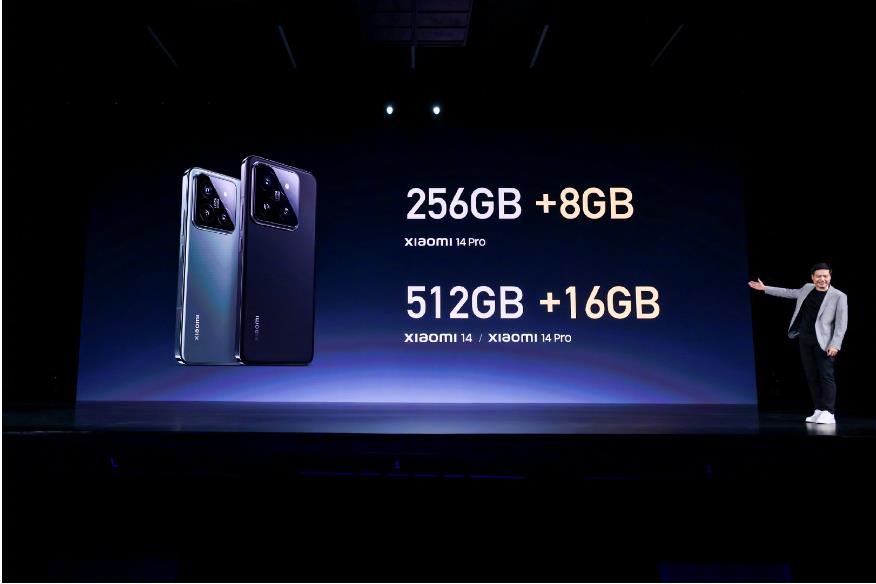October 30 th news, last week’s Xiaomi 澎湃 OS andXiaomi 14 At the launch of a series of new products, Lei Jun announced the launch of one. For 256GBXiaomi 14 Pro, users can get an extra 8GB of space, and for 512GB of Xiaomi 14 and Xiaomi 14 Pro, users can get an extra 16GB of space.

Today, Zhang Guoquan, director of Xiaomi’s mobile phone system software department, interpreted this function, saying that the "UltraSpace storage expansion" function will not cause life risk to UFS at all.
In addition, Xiaomi has contributed the standard to the UFS Association. In order to respect originality, Xiaomi asked chip manufacturers to do a little time protection.
The complete contents of IT House are as follows:
With regard to the storage and expansion function of Xiaomi 14 conference, I have read your feedback these days, and I feel it is necessary to talk about the ins and outs of this function. The text is very long, and students who are not interested in technology can only look at the questions and the answers in the first paragraph.
Why do you want to do this function?
Speaking shamefully, in the past few years, MIUI has been burdened with the nickname of "bloated", and has been vigorously rectifying in the past two years. From last year’s razor plan to this year’s storage expansion, it is a line of succession, and it is necessary to bid farewell to bloated completely.
In Razor Plan 1.0, except for some basic functions, other system applications can be uninstalled. In Razor Plan 2.0, the system firmware should be minimized, and the storage capacity should be expanded to ensure the maximum space available to users.
Ultra-thin Xiaomi 澎湃 OS is not only extremely brisk, but also saves a lot of space. Plus 8GB of hardware expansion, compared with the flagship of Friends, it can get up to nearly 20GB of extra space. In addition, the file deduplication and dynamic compression functions in the OS also improve the storage efficiency, which is not only large, but also more "durable". Taken together, after long-term use, it can store more than 30 or even 40G of data.
What is the technical principle? Will UFS have a life risk?
Not at all, everyone can use it with confidence, believe in the professionalism of Xiaomi and chip manufacturers, and don’t be rhythmic.
Simple science about bad block replacement management, because memory devices can only be replaced with reserved space units after bad blocks are found, once there is not enough reserved space, the memory chip will be completely unusable. We not only reserve enough space according to users’ habits, but also optimize the management of Cache to reduce the occurrence of erasure and bad blocks. At the same time, we support cloud control to adjust the reserved area of bad blocks according to users’ conditions after long-term use to ensure the stability of the system. According to the current model of heavy users, under the condition of writing 40GB of data every day, the expansion chip of 256GB can still be guaranteed for more than 10 years, and the expansion chip of 512GB can be guaranteed for more than 20 years. Please rest assured.
In order to ensure the best storage experience, it is necessary to realize the deep collaboration between the host file system and UFS, which has been reflected in the FBO’s refreshing storage function before. With the same concept, Xiaomi also deeply intervened in the resource management of UFS on the host side based on file management, realizing "data unnecessary non-writing (UFS)" through software, and "writing data unnecessary non-migrating" through software+firmware, reducing the amount of writing and achieving better wear-leveling.
Can the old model be upgraded and supported?
Need mobile phone manufacturers, supply chain manufacturers to match, and to do calibration when mobile phone production, so the old model does not support.
Why don’t some versions support the same Xiaomi 14?
For the sake of supply chain security, we purchased a number of memory chips. Although Xiaomi share all the technologies from the supplier, some manufacturers haven’t had time to adapt. In fact, there were objections a few days before the listing. Finally, General Manager Lei made a decision: Don’t waste good technology, just make it clear to everyone. If it is more than 8G/16G, it is normal to enjoy the technology. I hope everyone will understand.
Driven by Xiaomi, mainstream memory chip manufacturers at home and abroad will adapt one after another.
Can other manufacturers use this technology?
Xiaomi has contributed the standard to the UFS Association. In order to respect originality, we ask chip manufacturers to do a little time protection. In the near future, major mobile phone manufacturers should adapt to this function. Since its establishment, Xiaomi has always hoped to promote the progress of the industry with all manufacturers. This needs no explanation. It should be obvious to all.

According to Lei Jun’s previous introduction, the actual real space of a nominal 256GB mobile phone storage actually exceeds 275GB. Among them, 93.1% of the space is really available to users, and the remaining 6.9% is called Over Provision, or OP for short, which is the space occupied by internal management of the memory. This part of the space cannot be used during the use of the mobile phone.
Xiaomi has worked closely with memory manufacturers. . This process requires a deep understanding of the working principle of the memory to ensure that the OP area space is compressed without affecting the performance and life of the memory. After many tests and optimizations, Xiaomi found an ideal balance point.
. In this process, Xiaomi needs to deeply customize the file system to ensure that it can manage this new space correctly and efficiently. Xiaomi’s engineers have finally achieved this goal after countless experiments and optimizations.
关于作者